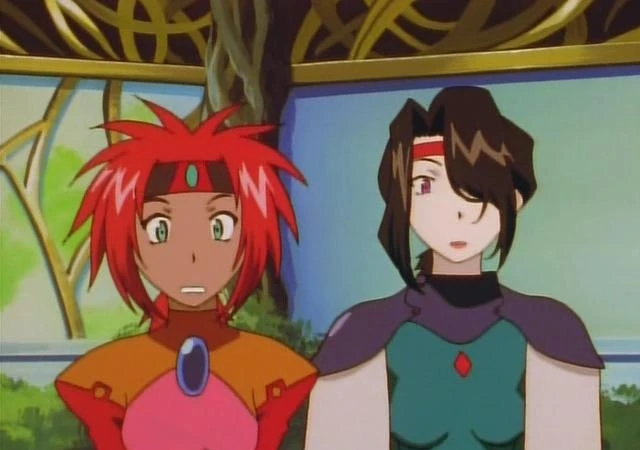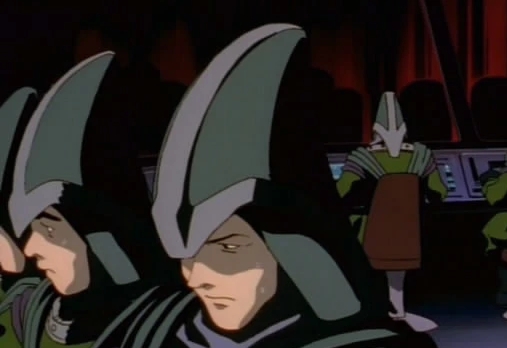El Hazard: The Alternative World
July 1, 2022 · 1 comment
By Andrew Osmond.

There’s a lovely moment in El-Hazard: The Alternative World, soon after the characters, many of whom were whisked from Earth to a new world once already, are transported into an all-new world. These characters include Makoto Mizuhara, hero of the franchise, who was a Japanese schoolboy until not very long ago, and his similarly-transported friend Nanami. Well, Makoto thinks of Nanami as just his friend, although Nanami’s feelings are growing more complicated toward him. They’re sitting at a royal banquet, not for the first time in the franchise, when their friendly Emperor host asks them where they come from. “Hey Makoto,” Nanami asks. “Which world is our world again?”
It’s not as if the youngsters are renouncing their identities as people of Earth, like the old sci-fi hero John Carter. The Carter stories by Edgar Rice Burroughs were a big influence on El-Hazard; they were acknowledged by Hiroki Hayashi, who directed the original series. But Makoto and Nanami have become very used to a life on a wondrous world, far removed from cram schools and student elections. In that way, El-Hazard anticipates the slew of “otherworld” (isekai) anime which would erupt a decade or so later, especially after Sword Art Online.
Fantasy author Jeannette Ng argues that one of the big differences between Japanese and Western otherworld fantasies is precisely the way that Earthlings whisked away in Japanese fantasies aren’t very interested in getting home. “Many of these protagonists have left their old lives behind, leaving the story to focus wholly on engaging with their new surroundings…The exile of the protagonist from our world functions like an invitation to delve deeply into intricate and bizarre lands, living out an entirely separate life.”

There are counter-cases, of course. As mentioned above, the American hero John Carter renounced Earth, as did his Hollywood descendant Jake Sully in Avatar. Conversely, in the Japanese blockbuster Spirited Away, it’s plainly impossible for Chihiro to live out her life in the spirit world, though it’s suggested it will live in her in the “normal” world. But El-Hazard keeps to Ng’s pattern of heroes who don’t need home, and The Alternative World reinforces that idea from the start.
The new story starts by highlighting all the romantic bonds that have been forged since the heroes came to El-Hazard. First, the youngster’s tipsy teacher Fujisawa has been pretty much railroaded into marrying the water priestess Miz Mishtal, who’s less worried about commanding the elements than her own body clock. As for Makoto, he’s not pining after Earth, though he’s still dreaming of the unearthly woman (and doomsday weapon) Ifurita, who he met in the first series.
Nanami, as mentioned earlier, is wondering if Makoto will ever notice her; in anime terms, she’s the “girl next door,” which stacks the odds against her. Indeed, she already has more competition for Makoto in the shape of the flamethrowing priestess Shayla Shayla. Meanwhile, across El-Hazard, the arch-villain Katsuhiko – who you might remember is Nanami’s big brother, though neither of them seem to – is still shouting at his Bugrom minions and plotting to rule the world.

And then, a couple of episodes in, nearly all El-Hazard’s large cast get mysteriously transported to another fantasy world, called Creteria. Visually, it’s very different from El-Hazard, dominated by a smoky city and a castle that’s more like a steampunk fortress. For fans of classic fantasy anime, it’s a bit like Dornkirk’s domain in the 1990s fantasy series Vision of Escaflowne.
That’s where Makoto and Nanami land up, although the other El-Hazard characters are scattered in other areas, from a freezing wasteland to a mountain that turns out to be flying in mid-air. Some characters will be forced into comically dysfunctional partnerships (that’ll be Jinnai and Shayla Shayla). Others will consider surprising life choices, and poor Makoto, naturally, will be forced to try to save another world.
Although the series is a direct sequel to the El-Hazard and El-Hazard 2 video series, both already available from Anime Limited in a single set, The Alternative World was made for TV. As such, it reflects a trend of the time for TV anime to be spun off from original video titles, rather than the other way around. Other celebrated examples were the Patlabor franchise, which began on video in 1988 before being remade for TV a year later, and the Tenchi Muyo! franchise, which shared El-Hazard’s studio (AIC) and co-creators (Hiroki Hayashi, Ryoe Tsukimura).
Pretty much all of the El-Hazard Japanese voice-actors carry over to the sequel, but The Alternative World had a new director, Yasuhito Kikuchi, who’d previously animated on Gainax’s Gunbuster and Nadia – The Secret of Blue Water. He’d later go on to direct science-fiction, helming Infinite Stratos and Macross Frontier, but he’d also direct one of the most popular “otherworld” anime where going home isn’t an option – That Time I Got Reincarnated as a Slime.
Andrew Osmond is the author of 100 Animated Feature Films. El Hazard: The Alternative World is released in the UK by Anime Limited.
Alyazia
July 8, 2022 8:15 am
That’s goood riview I have seen this anime awhile back and let me tell you it’s quite good worth a watch.. I feel the 90s animes are incredible